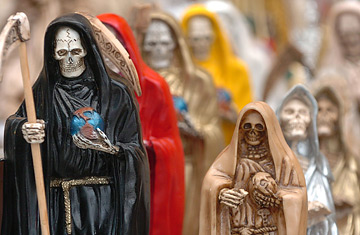
Dark Icon
Though not officially recognized as a saint by the Catholic church, Santa Muerte's popularity has spread significantly in the last ten years, especially in crime-ridden communities.
In a small shop in one of this city's largest Mexican neighborhoods, Laura Martinez scans rows of candles bearing the images of Saint David, Saint Raphael and Saint Jude. But she overlooks those and grabs two candles featuring Santa Muerte — Saint Death. "She's my patron saint," says Martinez, 24, who arrived here from a town outside Mexico City about six years ago. "You worship her," she says of Santa Muerte. "It's my religion."
Now appearing in New York, Houston and Los Angeles: Santa Muerte. The personage is Mexico's idolatrous form of the Grim Reaper: a skeleton — sometimes male, sometimes female — covered in a white, black or red cape, carrying a scythe, or a globe. For decades, thousands in some of Mexico's poorest neighborhoods have prayed to Santa Muerte for life-saving miracles. Or death to enemies. Mexican authorities have linked Santa Muerte's devotees to prostitution, drugs, kidnappings and homicides. The country's Catholic church has deemed Santa Muerte's followers devil-worshiping cultists. Now Santa Muerte has followed the thousands of Mexicans who've come to the U.S., where it is presenting a new challenge for American Catholic officials struggling with an increasingly multicultural population.
Santa Muerte's precise origins are a matter of debate. Some experts say its roots lie with Aztec spiritual rituals that mixed with Catholicism during Spanish colonial rule. What is clear, however, is that Santa Muerte developed a large following only in the last quarter century among Mexicans who had become disillusioned with the dominant Church and, in particular, the ability of established Catholic saints to deliver them from poverty. Residents of crime-tossed neighborhoods like Mexico City's Tepito began revering Santa Muerte more than Jesus Christ, experts say. Some of its devotees eventually split from the Catholic church and began vying for control of Catholic buildings. That's when Mexico's Catholic church declared it a cult.
Santa Muerte began appearing in U.S. neighborhoods with large Mexican populations only in the last decade. Walk down 26th Street in Little Village, one of Chicago's largest Mexican neighborhoods, and you'll notice the tiny shops, or botanicas, selling statues, candles and palm-sized prayer cards bearing Santa Muerte's image. There are references to Santa Muerte in Spanish-language newspapers. Young Mexican-American men are marking their bodies with Santa Muerte tattoos to prove their devotion. Middle-class, suburban-bred Mexican-Americans are snapping up black T-shirts bearing Santa Muerte's image to reconnect with what they perceive to be part of their heritage. Recently a Chicago art gallery opened an exhibit showcasing images from Tepito — with Santa Muerte figuring prominently. And Santa Muerte may gain even more credibility with the release of Saint Death, a new documentary about the phenomenon, narrated by Mexican actor Gael Garcia Bernal.
"It's become commercialized," observed Isabel Montalbo, manager of a botanica here. On a recent afternoon, Montalbo stood behind rows of oils with names like gota de amor (oil of love) and across from several jars of herbs, like epazote, cuassia chips and anise. Not far away were several large statues of Santa Muerte, some costing as much as $300.
Nearly 40% of the Chicago Catholic archdiocese's 2.3 million members are Latino, most of them Mexican. Catholic officials here have certainly taken notice of Santa Muerte's growing popularity: the archdiocese has encouraged priests with large Mexican populations to address the so-called saint's rise from the pulpit.
Just a few days ago, Father Marco Mercado, of the Good Shepherd Catholic Church in Little Village, visited a parishioner's home. As is common in Mexican residences, there was an altar with several Catholic saints. One statue, however, stood out: Santa Muerte. Father Mercado recalls telling the parishioner, "This is Santeria — it's not good! It's not at all connected with the Catholic faith." Many of Good Shepherd's roughly 3,000 parishioners have ignored Father Mercado's calls to destroy their Santa Muerte statues, candles and prayer cards, fearing that doing so will bring sudden death to themselves or family members. Now, he tells parishioners to bring Santa Muerte artifacts to the church. "I'll destroy it," he says.
Chicago church officials appear to be among the most aggressive in addressing the rise of Santa Muerte. Catholic officials in New York, Denver and Phoenix say they are unaware of Santa Muerte's increasing popularity in their communities. Father Oscar Cantu of Houston says he has watched botanicas and Santa Muerte gain popularity in his largely Mexican-American community, particularly among poor, uneducated immigrants. Father Cantu says he has made clear to his members that Santa Muerte is in conflict with the church's teaching. However, he says there has been little discussion about the topic among the broader church leadership. "It's probably time they receive some clarification that this is a distortion of our faith," he says, adding, "This poses a challenge for the church." (The U.S. Conference of Catholic Bishops hasn't issued an official position on Santa Muerte, partly because it is a relatively new phenomenon in this country.)
Back on Chicago's 26th Street, an elderly woman is at a cart, slathering sliced mangoes with chili. Laura Martinez steps out of the botanica, into the evening's cool air. "I'm Catholic and Santa Muerte," she says, carrying a plastic bag with two candles and a prayer card. She says she doesn't go to church, partly because she's too busy, but also "because of everything you hear with priests," referring to the recent abuse cases. At home, she prays at an altar with a spot only for one saint: Santa Muerte. "She's jealous if there are any other saints around," she says, adding, "She brings me good luck. I got my job because of Santa Muerte!" With reporting by Lourdes Vasquez/Chicago
